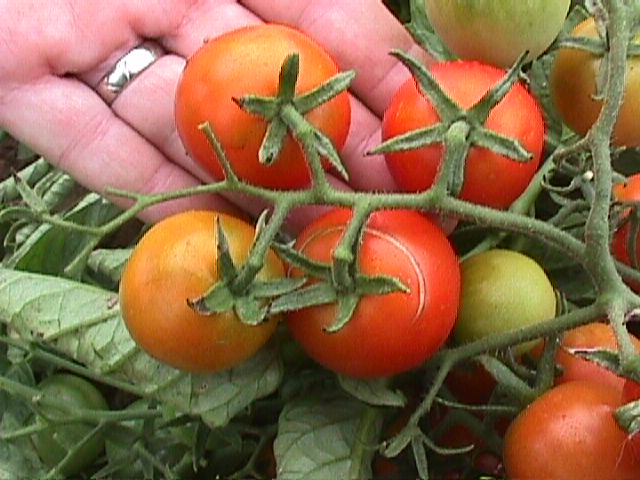VEGETABLES FOR THE NEW MILLENIUM
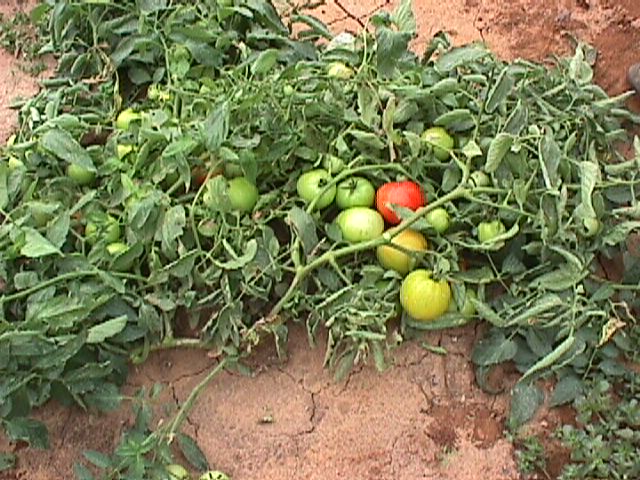
'LARGE, HEALTHY SURPRISE' TOMATO
The 'Large, Healthy Surprise' tomato is resistant to Tomato Spotted Wilt Virus (TSWV) and has been selected specifically for spring production in Texas where the TSWV disease is a serious problem. 'Large, Healthy Surprise' tomato is a heavy fruit setter with early to mid season maturity (usually about 80 days from transplanting under moderate temperature conditions). 'Large, Healthy Surprise' tomato produces an outstanding volume of fruit. Yields of over 20 pounds of premium fruit is possible under better conditions and strong cultural programs as outlined at:
http://aggie-horticulture.tamu.edu/plantanswers/tomato.html
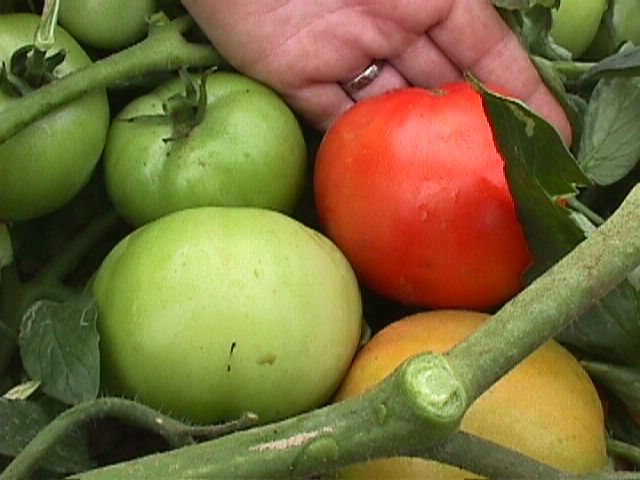
'Large, Healthy Surprise' tomato plant vine cover and vigor are good. The fruit has an attractive globe shape and is uniform green shouldered, i.e., ripens without any green shoulders. 'Large, Healthy Surprise' tomato produces a high percentage of large and extra large fruit with good red color, good firmness and flavor. The 'Large, Healthy Surprise' tomato plant is resistant to Verticillium Wilt, Fusarium Wilt (Races 1 & 2), and Tomato Spotted Wilt Virus (TSWV).
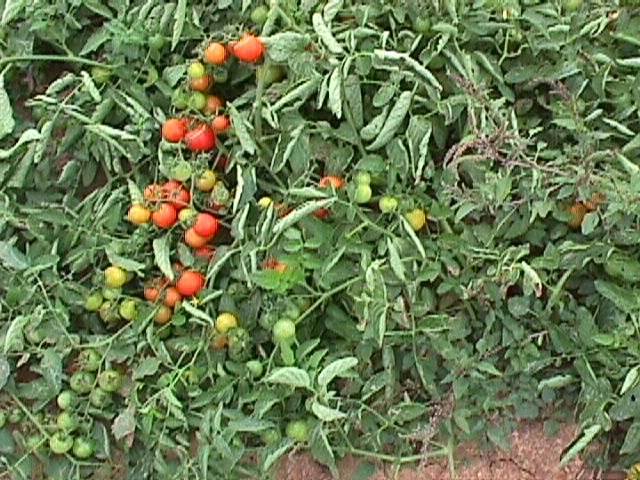
'ABUNDANT CHERRY SURPRISE' TOMATO
The 'Abundant Cherry Surprise' tomato is a premium,,extra firm which features very early maturity and produces excellent harvest volume or yields. The 'Abundant Cherry Surprise' tomato plant growth habit is tall determinate. Vine cover is very good. Fruit is a globe shape with smooth shoulders. The 'Abundant Cherry Surprise' tomato fruit ripens to a very attractive full red. Fruit size is small to medium and the size is consistent. The 'Abundant Cherry Surprise' tomato is a premium, extra-firm variety with a very good flavor. This firmness allows less frequent harvest, and simultaneous harvest of an abundance of ripe fruit. The 'Abundant Cherry Surprise' tomato plant has disease resistance to Verticillium Wilt and Fusarium Wilt (Race 1). Yields and earliness can be enhanced with improved growing conditions and strong cultural programs as outlined at:
http://aggie-horticulture.tamu.edu/plantanswers/tomato.html
The most productive cherry tomato ever grown in Texas. It is the only heat-setting
cherry tomato ever tested in Texas. The cherry tomatoes are large marble size
produced on a semi-determinate plant. Taste varies with taster.
The 'Dwarf Cherry Surprise' is the first large cherry tomato to be produced on a determinate (small) plant. The "surprise" refers to the amount and size of tomatoes produced.
Let us know how it does for you: telephone your comments to 210-467-6575 or e-mail your comments to Jerry Parsons at jerryparsons@tamu.edu or via the WebSite http://aggie-horticulture.tamu.edu/PLANTanswers/web.html.
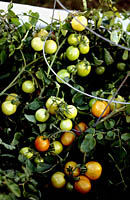 Click on image to enlarge. |
You can find more information about growing tomatoes at the PLANTanswers site:
http://aggie-horticulture.tamu.edu/plantanswers/tomato.html
Or send a self-addressed, stamped envelope to: Tomato Growing, c/o Jerry Parsons, Bexar County Extension Office, 3355 Cherry Ridge Street, Suite 212, San Antonio, Texas 78230-4818.
Transplants of tomatoes, peppers and eggplants should be established now so they can be blooming profusely when the optimum fruit-setting conditions occur. But, the last predicted freeze is not until early March. The solution is to buy plants with the intention of producing bi-transplants (a bi-transplant is a regular transplant which will be planted twice instead of once). Purchase transplants with the idea of putting them in pots instead of the soil. A plant in a pot is portable. This means that you can react when temperatures are forecast for 35 degrees F. You know from experience this means either 25 degrees F. or 45 degrees F. so now you can move your portable plant to a protected location. If the colder temperature occurs, you and your plants can sit by the fire while those who transplanted directly into the garden too early are soiling every blanket in the house and receiving frost bite on their backs trying to protect exposed plants. Even if they succeed, the effort won't prevent the growth-retarding effects of cold soil.
The potted plant expands its root system at a faster rate than one in the ground because the potting soil will be warmer and porous. Never use garden soil in a container - instead, purchase a well-draining potting mix. Since the mix contains no fertilizer elements, mix in the label-recommended amounts of slow-release fertilizer pellets such as Osmocote before planting in a gallon-size container. Add a water-soluble fertilizer such as Miracle-Grow, Peters 20-20-20 or Rapid Grow to the water each time the plants are moistened.
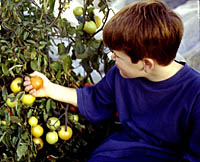 Click on image to enlarge. |
'Hoffman Cluster Surprise' Tomato
Lycopersicon lycopersicum
Highly productive indeterminant tomato with a profusion of cherry-
sized tomatoes produced in a large cluster in the summer. 69 days from
transplant.
Exposure: Full sun with good drainage
Size: 3'T x 5'W
Fruit: Smooth, red, cherry-size
Planting time: Spring, after last frost.
Care: Fertilize before planting with a slow release fertilizer, then
every 2-3 weeks with a quick release nitrogen source.
A new and popular tomato product is a cluster of vine-ripened fruit still attached
to the stems. These products are known as 'cluster tomatoes', 'cluster-harvested
tomatoes', 'truss tomatoes', or 'on-the-vine tomatoes'. The term 'truss tomatoes' is
frequently used in Europe, and 'cluster tomatoes' is used in the United States. This
new way of marketing tomatoes is credited to Italian producers who first began
testing in 1989. The popularity of this vine-ripened product quickly swept through
the European greenhouse tomato industry, and more recently the North American
industry. Most currently grown varieties are indeterminate meaning they tend to be
taller plants requiring high trellis systems. The clusters are harvested by clipping
the main cluster stem from the plant. All tomatoes on the cluster remain attached,
and range in maturity from breaker to ripe. Prices vary, as with other tomato
products, but they frequently sell in grocery stores for $2.00 per pound. Many
cluster tomato varieties have outstanding flavor and appearance to compete with the
best of the vine-ripe tomatoes sold. In addition, consumers are highly attracted to
the to the tomato aroma provided by the stems of the cluster. Outstanding fruit
quality and shelf-life allow the consumer to pick tomatoes from the cluster over
several days. Try the 'Hoffman Cluster' tomato and see if you like it.
'Parsons Potent Chili Penguin'
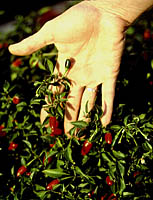 Click on image to enlarge. |
It has been concluded that the heat of the pepper can cause a discharge of endorfin from the brain to the nervous system of the consumer. These are substances which produce a sensation of well being. In the continuing use of pepper the discharge increases and the reaction of irritation and ill-feeling is replaced by pleasurable results of its consumption. Finally the pleasurable result is stronger than the sensation of pain it causes.
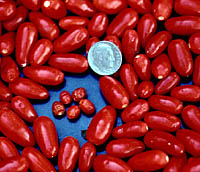 Click on image to enlarge. |
THE COUGH: There are three remedies to cure the cough through the use of pepper. If it is a light cough you eat a light pudding with yellow pepper and honey. If the cough persists, an infusion of teauaxin with pepper and salt is used. A third treatment consists of a tea from roots of tlacopopoth (Arundinella hispida), or lime water mixed with pepper. This medicine can cure your cold or flu. Within the European medical theories, adopted by the Indian medicine the hypocritical says all things of the universe have opposite characteristics such as, hot-cold dry-humid. The cold was opposite to the hot and humid to dry. A healthy body maintains these contrast in equilibrium but when sick, there is a great load on the temperatures and when you recuperate, your equilibrium depends on the nourishment and medicine that contain the adverse qualities of those your illness provoked. The hot sauces like pepper are considered "hot". They were prescribed for sickness pertaining to "colds". It is frequently used for coughs due to colds, bronchitis, asthma, irritated throat and congestion. It is used in gargle form, balm or ointment made from the pepper and the leaves. It was known that infusions were good. It was a hot remedy!
TONGUE INJURIES: Apply a mixture of pepper cooked with salt on the injury of the tongue. In this case it was probably used as an antiseptic.
THE TEETH: You can take the toothache away, applying a hot pepper with salt to the affected tooth. If your gums are hurting, apply the same rule to reduce the infection. Recent studies have proven from the pepper works against pain, since it affects the body at the brain. Also pepper contains vitamins A & C essential to the good health of the gums and teeth.
In the past few years, it has been discovered that the Capiscina from the pepper functions as an agent against pain. The chemical substance from the brain named "P" is directly related to the transmission of pain. Scientists have found capsicina stimulates selectively and will destroy the substance "P" in certain nerves that end in the skin and the mucous membranes. In this way it works as an anti-sensibilitant. This phenomenon has been observed in the cardiovascular and respiratory systems where there is a relation in the effect provoked by the capsicina and the substance "P". The discovery of the effectiveness of applications of capsicina to the dental nerve of the socket to reduce the substance "P" as a transmitter for the pain in the dental pulp justifies the pre-Hispanic remedy to utilize hot pepper to treat the pain of a tooth.
DIGESTIVE TRACT: Known functions of the pepper is to incite your appetite, because of its ability to foment saliva secretion in the mouth. It plays a physiological role in the nourishment of natives because it secretes the saliva that does not break through in your mouth when, every day of the year and of your life you take the same meals, tortillas and beans. When your taste sensibility grows dull and weak you need more pepper sauce so your food will not taste like rags. Every day the sauce will need more serrano to give your meal more taste.
The Mayas utilized the pepper to cure an illness where the symptoms started by showing blood in your urine and feces. That also works on your stomach ache and it provokes diarrhea. For stomach ache, yellow tomato juice mixed with pepper is recommended. The Mexican people would treat a colic with a suppository made of lime nitre, sap of liquidambar and pepper. With that remedy you would probably get a pain more intense than the original. The cure is worse than the illness.
CONSTIPATION: This problem is treated with pepper and saltpeter in water.
HEMORRHOIDS: These are also treated with a remedy made with pepper. I'll bet they wished for the 'Parsons Potent Chili Penguin' -- they could cauterize those hemorrhoids in one "pass".
BEAUTY AIDS: Beside its medicinal qualities the pepper has been used as a beauty product too. To smooth your face skin, it is recommended to wash your face with warm urine and apply pepper (yellow chilcozth). The pepper in this case may serve the purpose as an astringent. Once you smooth your face skin you definitely want to be more attractive to the opposite sex so use another remedy which suggests that women bathe in pepper water to increase their sexual attraction.
APHRODISIAC: It was advised that the male not over use the pepper because it is prejudicial (hurtful) to their health, mainly because it provokes sensuality. It was famous for that when it was introduced in Europe in the 16th Century. Presently in many countries, it is still related with sexual desires hotter than a pepper! Like many parts of the world, in the Arab nations, they attribute sensual qualities. In Samoa the pepper is one of the ingredients of Kava, a love potion of virility.
STIMULANT: The consumption stimulates perspiration so it lowers the internal temperature of your body. As a home remedy, it is a stimulant for hair growth. There are some who will put them in their socks for better circulation and to keep the feet warm in cold climates. I can imagine it now, chile piqins between toes - watch out Dr. Scholls - here we come.
In Malaysia it is used over the abdomen as a stimulant at the time of childbirth. After birth it is used internally to expulse the afterbirth.
STIMULANT: The consumption stimulates perspiration so it lowers the internal temperature of your body.
Researchers at Britain's Oxford Polytechnic gave twelve volunteers identical 766-calorie meals. On one day, 3 grams each of hot chili and mustard were added (about average for a super spicy meal); the next day, no spices were added. Result: After eating the spicy meal, the subjects burned off an average of 45 extra calories over the next three hours. It seems that hot spices temporarily speed up your metabolic rate. This means an obese person could transform into anorexia with several pods of the not-even-funny-it-is-so-hot regular jalapeno "killer".
THE EAR: Apply drops of pepper powder boiled with liquor to ease an ear ache caused by the cold. This combination of liquor and pepper was an early sign secrecy of colonial medicine.
REMEDY FOR TOO MUCH PARTYING: Picante sauce with garlic is exceptionally good
for a hang-over. It is very popular to overcome discomfort caused by a night on the
town. I assume that this is the origin of using tomato juice as a hangover remedy.
Arthritis and Sore Joints:
QUESTION: My Dad listens to your show all the time, and was wondering if you could quite possibly send him the homemade recipe of Capzasin? He says you will know what I'm talking about. When you did this recipe he missed it, and would really like to try it.
ANSWER: Tell your dad that the mix I used contained 6 chile piquins (regular size)
and one heaping tablespoon of Vaseline. Of course you can make it stronger (with
more piquins) or weaker (with less piquins or more Vaseline). Just crush and
thoroughly grind the piquins in the Vaseline. I put the mixture in the microwave for a
few seconds to "smooth" the mixture by melting it some. After applying the mixture,
wait for at least an hour for results, i.e., whether to mix a stronger batch. Also, and
more importantly, to eliminate the capsaicin (heat-giving chemical) from the hands,
wash thoroughly in a chlorox-water (two tablespoons chlorox in a quart of water) or
be REAL careful if you touch a "sensitive" part of your or a loved one's body!
Oscar Dwarf Okra Surprise
A smooth-podded, early maturing okra with a mid-sized (5-6 feet tall) plant.
'Crawford' Re-seeding leaf lettuce
A red-tipped leaf-lettuce which re-seeds itself year-after-year if allowed to bolt (flower) and mature seed.
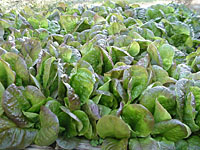 |
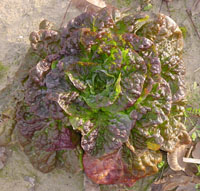
Click on image to enlarge. |
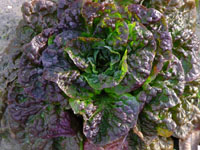 |
